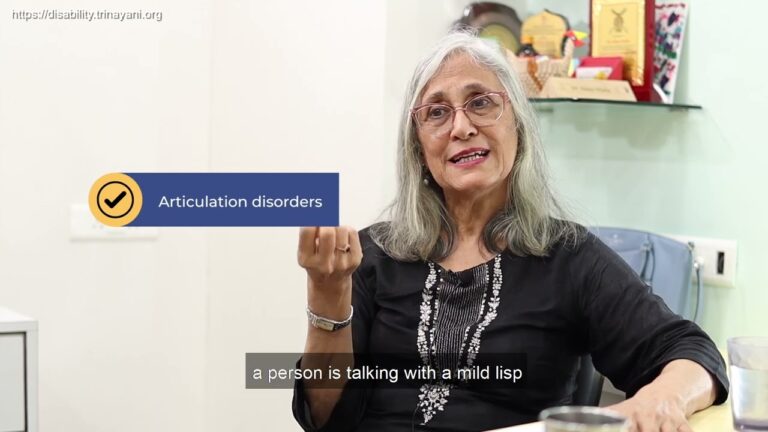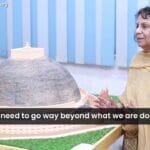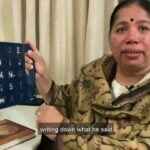Pioneering Assistive technologies
Our film on the work being done at IIT Madras Research Park highlights the innovative strides in assistive technologies being made by the dedicated teams here, led by Professor Sujata Srinivasan. She runs two key centers: the Center for Rehabilitation Research and Device Development (R2D2) and the National Center for Assistive Health Technologies (NCAHT). R2D2 focuses on developing life-changing devices for people with locomotor disabilities and NCAHT raises awareness and educates people about disability, offering a hands-on experience with various assistive devices.
Joining her is Justin Jesudas, who oversees operations at R2D2. In this film, he shares his insights into how technology can bridge the gap between ability and disability and improve the quality of life for millions. See how IIT Madras is creating a more inclusive and accessible world through this film!
I’m Sujata Srinivasan, I’m a professor in mechanical engineering at IIT Madras and I run two centers here.
Uh one is R2D2, the TTK center for rehabilitation research and device development and last year we inaugurated this uh the National Center for Assistive Health Technologies at the Research Park, IIT Madras Research Park, which is an initiative of ICMR.
So, ICMR has uh established these National Centers for Assistive Health Technologies, uh in four places, uh IIT Madras is one of them and we focus on locomotor disability.
There’s also one at IIT Delhi, which focuses on visual impairment.
There is one at AIIMS Delhi and one in the National Institute of Speech and Hearing at Trivandrum.
Uh so all of them focus on different disabilities at uh NCAHT, IIT Madras, we focus on locomotor disability.
So, at R2D2, which is about uh 9 years old, we’ve been developing assistive technologies for persons with locomotor disability.
So, that is our focus.
And our focus is not just developing prototypes but uh we’ve managed to take five of these devices to the market with industry partners as well as our own startup.
We continue to develop more devices there but we realized after a point that, you know, just developing assistive technologies is not enough.
There are lots of other challenges in terms of awareness that need to be addressed.
And that’s how we created NCAHT, the National Center, uh here as an awareness zone, as a place for people to come and experience disability and ability, to look at various devices that are uh available uh for locomotor uh disability.
And also, you know, conduct dissemination programs uh dissemination and outreach programs uh to educate people about uh disability, about uh the clinical aspects of disability as well as uh how assistive technologies can help improve uh lives.
With me here is Justin Jesudas, uh, he heads operations at uh R2D2 uh and has been instrumental in helping us uh you know uh do the things that we do.
Justin, over to you.
India alone could be home for about 90 to 130 million people with disabilities.
Um I think there is a divide, uh between ability and disability and technology could be one of the biggest enablers that bridges this gap.
Uh with the right technology, we can start seeing more people in the community participate in the community.
We operate in a model called GRID model where G stands for grants, R for research, I for industry, partner onboarding D for dissemination.
Uh and IIT typically, IIT Madras what R2D2 does is, it’s a grant multiplier.
While we get the grants, financial stuff, but there are other resources that come together to create this technology and take it to the people in the right manner.
Uh for example uh for a pair of spectacles, we have uh prescriptions, but for wheelchairs, we don’t need prescriptions.
That needs to change.
So some of the things that we do is not just device development, designing great devices, but we also have teams that actually goes and reaches out uh to the clinical professionals, rehabilitation professionals, users, policy makers, to let them know that uh things need to change, the narratives need to change.
Uh essentially at the end of it, uh, we are simply, through technology and through dissemination, we want to ensure the quality of life of persons with disability is way better than what it is right now.
So we realized early on, that you know, having nice prototypes in the lab is not enough.
If we really want to make an impact, we have to take our devices to the market.
And so we have to work with industry partners to do that.
Our first device was the Arise standing wheelchair, which is a manually operated uh uh wheelchair that helps the user to pull themselves up to the standing position, while sitting in the wheelchair.
It’s a completely manually operated device and it’s also good for, like, you know, traversing uh um say a 2 km distance, even in rural areas.
It was primarily targeted at uh the rural population.
Then uh we also have uh an active wheelchair called NeroFly uh which is uh very ergonomically designed.
It’s customized to the user.
It has a lot of adjustments that help the user make the most of a manual wheelchair, has very good propulsion.
This is a wheelchair made by NeoMotion, uh this is called NeoFly and this is called NeoLight.
There are subtle, uh subtle differences in the customization.
We can see that tyre is different, this is a more of a uh regular use tyre and this is an offload tyre, people can swap it and you can uh find a lot of adjustments available in the wheelchair.
The front wheels can be changed, the breaks can be changed.
Uh, the height can be changed, the angle can be changed, the cushions can be changed.
The color can be changed based on the personality of the person.
So giving all these options is really important for the person to own the device and then become confident in moving outdoors and participating.
And the specialty about this version is, it’s very light in weight, so it’s half the weight of these regular devices and this makes it easier for people to pick up the wheelchairs and place it in the car or auto and become even more independent.
With it you can attach a device called the NeoBolt, which is a motorized, uh device that converts the NeofFy into a road worthy vehicle.
So, with that you have seamless indoor-outdoor mobility, a person can uh, you know, be outdoors with a NeoFly and NeoBolt, come back and when they want to go indoors, they just detach uh the NeoBolt, lock it and go indoors.
Uh so that’s uh uh that we commercialized through our own start-up
NeoMotion.
Uh and then recently, we also uh created a motorized version of the standing wheelchair because we realized that not everybody can operate the manual version, even though it takes very little effort.
Uh but people for higher levels of say, spinal cord injury, they may not have the hand function and arm strength to operate the manual device.
Uh so we came up with a motorized version and that is also being commercialized by NeoMotion, that’s called NeoStand.
And with the push of a button, the user can go from uh sitting to standing, and it’s also good from a therapeutic standpoint because standing can be performed gradually.
It can stop at intermediate positions.
It can even move, you know, as long as the person can reach the push stems, they can also move around in the semi-standing position, which can be very advantageous if you’re doing chores around the home.
You don’t have to sit and stand each time.
So that uh was the uh uh that was one more device. Then uh in prosthetics uh, we designed a polycentric knee, which is, you know, India’s first indigenous design of a polycentric knee uh specifically meant for walking on uneven terrain, because that’s what we encounter every day.
So the geometry of the knee is optimized in such a way, that the user has better control when walking with their artificial leg, using this knee.
So, these are two examples of prosthetic knee joints.
Uh this is the one which is commonly available for uh most of the people.
This is a single access knee joint, you can see the knee just wobbles uh and when a person is walking, it may be very difficult to control the movement and it will look awkward, it may not be very close to, you know, natural way of walking.
So this is called a polycentric knee joint, you can, you can see it’s not wobbling like the previous one, it’s not hinged like the previous one, but this is a polycentric joint.
So, the movement is very smooth, and the person can even do activities like squatting down to the floor and it’s very useful for people in India.
The National Center for Assistive Health Technology, IIT Madras is essentially an experience center uh for users primarily, so users can call the center their own.
They can come here and experience the potential of assistive technologies, what it can do to uh their life.
90% of the wheelchairs that are sold in India are hospital grade wheelchairs, not meant for community use.
Uh similarly 60% of prosthetics researchers say, some researchers that are rejected by uh people with amputation because it’s not made primarily for them or it’s not customizable or different challenges there.
So here they can come, look at different compar…comparing technologies, be it for standing or for mobility or you know, mobility could be through wheelchair or prosthetics or orthotics uh even stair climbing chairs, so, and sports technologies as well.
So this place displays those technology, technologies, and people can compare and choose what’s appropriate for them,
But not just that. Uh for policy makers, this is kind of uh you know, an eye opening uh center where they come and see uh what are the different architectural barriers that uh that are out there and uh what day-to-day wheelchair users or prosthetic users or any other mobility aids users, kind of encounter in the community.
We’ve stimulated those architectural barriers here.
To cross a surface which is challenging, there the four different methods, this is Rolling Straight on the surface.
The next method will be even more easier, which is called Popping Casters, so the front of wheelchair will be lifted at smaller intervals, so that it doesn’t get stuck.
And the next method is Continuous Wheelie, the front of wheelchair will be lifted continuously, it requires more skill and this will be a bit challenging but will be the fastest method to overcome the surface and then Rolling Backward.
It’s less challenging but it will be very time consuming and more energy consuming.
This is the place where we want to showcase, you know, true diversity and inclusion can actually happen and it’s much more fulfilling when it happens.
The wheelchair skills program is completely free.
Uh we provide uh the training along with accommodation and food as well.
Uh so that’s that’s how we, you know, initially wanted to…we’ve run about five, six programs now uh and we’ve had about 60 to 70 users come and benefit out of it and it’s been completely uh free.
Uh what we’ve noticed is the first two three programs, uh people not, have not had that educational background or coming from rural areas.
But in the last two-three uh training batches, we’ve seen medical doctors come in, PhD, people who’ve done masters in hospital management.
So we’re starting to see that change that’s really happening uh which I think is great for the society as well.
We take about 10 to 15 people because we didn’t want to overload because apart from the training, we also do community program.
We take them out into the community.
Hailing a cab or taking a metro, going to the beach or to a movie, we want them to experience that and having larger batches would, you know, kind of, pose a challenge.
So we’ve been doing this in small batches.
This runs for two to three weeks, depending on uh whether it’s an intermediate skill or beginning skill or advanced skills.
So in the journey from, you know, um say hospitalization after an injury to being able to use assistive devices, there’s an important component that is usually missing and that is “rehabilitation”.
And that’s partially because, you know, uh access uh to rehabilitation is uh uh very poor and the number of therapists that are available to administer rehab versus uh the number of people who need it, that ratio is very poor.
It’s something like 1:25,000.
One therapist for every 25,000 people who need rehabilitation.
So, technology can help uh fill that gap and so we have been working with the CMC Vellore um to develop devices and our new startup Thrive Rehab uh will be commercializing uh the these uh set of devices.
We’re working on devices for, say hand-neuro rehabilitation, after stroke.
So, and and our idea is we want to take rehabilitation to the bedside.
You know, you start from the bedside and you should be able to also take it home.
Because only when there is that intensity uh that is achieved uh um, you will see that uh progress and you will see that func…function returning uh to the uh uh user.
So, Pluto is a hand rehabilitation robot that we have developed.
Uh, very simple, can be packed and taken even on a two-wheeler by a therapist to rural areas.
There’s a home version that people can use at home.
It’s been extensively tested. It trains hand function,
So we have uh some other rehab projects going on.
We have a prosthetic foot that we are uh working on that we hope to uh launch later.
I think what we are able to do at R2D2 is apply scientific rigor to the development of these devices.
Um so it’s not just, you know, we understand the problem usually comes from a real need because there is extensive user input in the process right from the need definition to the usability of the product.
You know, we hope that when we are actually ready to go to market with our partners, it’s a well-tested uh well-researched product that users will actually uh adopt easily.
Is there concern about the pricing and availability of assistive devices for people who may not be able to afford them?
We are we try to use appropriate technology and the Grid model also helps keep things affordable because pretty much all the R&D costs are absorbed by uh, you know, the grants that we get and the facilities that we have at IIT Madras.
So we just license the technology, the companies pay a small licensing fee and that’s one way we keep the uh final price very affordable.
If, uh, you know, there are people who can’t afford it, they partner, like for instance, NeoMotion partners with companies who give CSR, who provide these devices through CSR.
People also realize that, if with these devices, if they can do more, they can get themselves educated, they can go for employment, then they don’t mind figuring out how to pay for these devices.
There are also financing options, uh that are there.
And policy makers also have to get out of this mindset that rehabilitation or, you know, assistive technologies is just about charity and therefore they have to look for the cheapest things to get the numbers.
What is the point of a wheelchair, that’s donated for free that is uh of no use to the person uh it’s donated to, right?
Once that awareness sets in, I mean we’ve had policy makers come through here and they see the difference, some of these devices make, in the lives of people, how people can start contributing to the economy, start paying taxes, you know?
So you have to look, look beyond just the uh cost of the device and again that’s a mindset change.
People are willing to spend uh thousands on smartphones, right?
If they know that there is a benefit to it, you’re going to go for the best smartphone that you can afford.
It also has to be policy change, in terms of insurance and you know, uh what devices are covered, how they should be covered, so the government has to think about uh these things at a policy level and I think the
Niti Aayog, they’re…they’re starting to do these things.
I think now we have helped bring the spotlight onto assistive technologies with some of these innovations.
Uh and uh the impact that we are able to showcase with them, we are able to put the spotlight on assistive technologies and that’s why they’re more than willing to engage and try to figure out solutions to some of these uh problems.
Now we’re looking at the next generation of devices, you know, smarter devices uh um etc and we have another startup called “Thrive Mobility” that uh Justin will be uh spearheading uh which will work on some of these uh newer devices and I’ll let Justin uh describe those in some more detail.
So we’re playing around with a lot of uh mechatronic and electronic solutions, little bit of robotic solutions, wearable devices, how they integrate with the traditional wheelchair and how can you make them smarter.
So those are things that we are working on.
Yeah, I think the last decade was all about laying the foundation and uh you know filling the gaps wherever we didn’t have the appropriate technologies.
I think the next decade is going to be uh doing a catch up a little bit and then, you know, going beyond that and showing the world that India is capable of putting out these devices, real good technologies and the most important thing is, we should be able to take these devices to the global markets.
I think that’s when you get the volumes and uh you know this uh entire thing of assistive technology, volumes low, uh not being able to uh break even, that narrative will start changing.
And overall, not just Thrive or NeoMotion, if you look at the entire ecosystem that we’ve created, right from R2D2 to NCAHT and these startups, uh one unique thing is, this has all the stakeholders coming in together.
Be it researchers, academicians uh engineers, different disciplines of engineers, clinical professionals, be it occupational therapists, physiotherapist, social workers and peers themselves, users themselves.
So that’s how we’ve been able to crack uh the customization problem and the user centric design uh challenge and that’s the reason why often we see a lot of users of our devices absolutely loving them.
accessibility, accessibility awareness, accessible solutions, assistive devices, assistive technology, disability awareness, disability education, disability empowerment, disability inclusion, health technologies, IIT Madras, inclusive design, Inclusive India, inclusive innovation, inclusive research, Justin Jesudas, Locomotor Disability, mobility aids, NCAHT, R2D2, rehabilitation research, Research Park, Sujata Srinivasan, technology for good, universal design
Dive Deeper: More on Disability
Learn about the most common inquiries surrounding disability, education, legislation, accessibility, employment and other sectors related to disability.


















